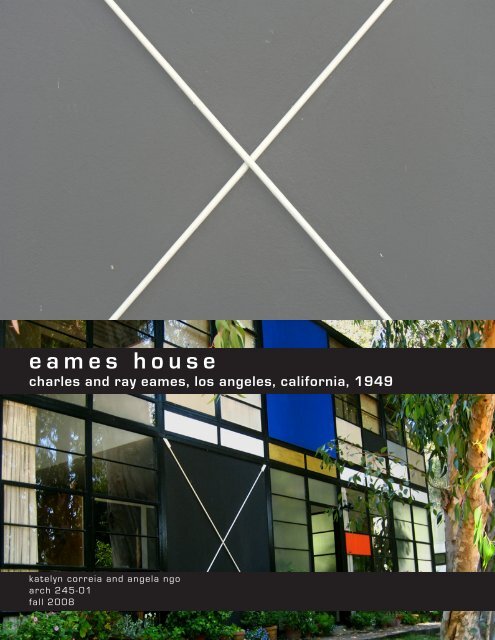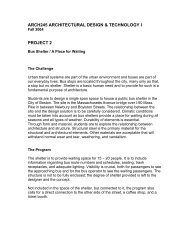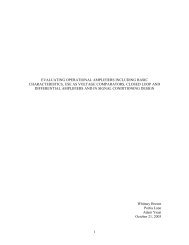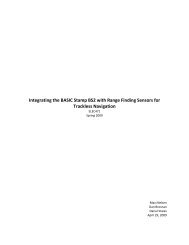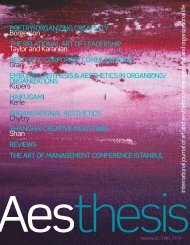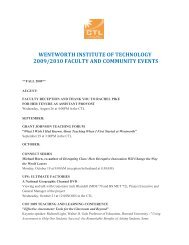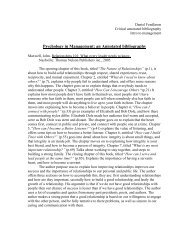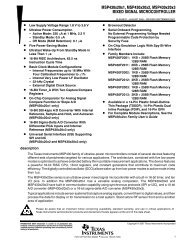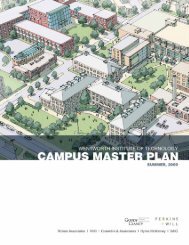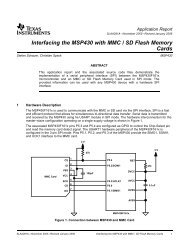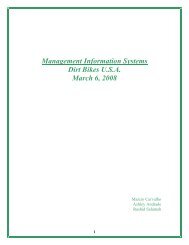eames house - MyWeb at WIT
eames house - MyWeb at WIT
eames house - MyWeb at WIT
You also want an ePaper? Increase the reach of your titles
YUMPU automatically turns print PDFs into web optimized ePapers that Google loves.
<strong>eames</strong> <strong>house</strong><br />
charles and ray <strong>eames</strong>, los angeles, california, 1949<br />
k<strong>at</strong>elyn correia and angela ngo<br />
arch 245-01<br />
fall 2008
contents<br />
introduction to the <strong>eames</strong> <strong>house</strong> 1<br />
base drawings<br />
site plans 3<br />
plans 5<br />
elev<strong>at</strong>ions 7<br />
cross section 10<br />
diagrams<br />
kit of parts 11<br />
m<strong>at</strong>erials 12<br />
structure 13<br />
structural grid 15<br />
program 16<br />
actual spaces 17<br />
suggested spaces 18<br />
indoor/outdoor 19<br />
public/priv<strong>at</strong>e 20<br />
circul<strong>at</strong>ion 21<br />
mass and void 22<br />
hierarchy 23<br />
gravity loads 24<br />
photographs 25<br />
thesis 30<br />
annot<strong>at</strong>ed bibliography 31<br />
i
introduction to the <strong>eames</strong> <strong>house</strong><br />
The Case Study Houses were experiments in American residential architecture sponsored by John<br />
Entenza’s Arts & Architecture magazine. Husband and wife Charles and Ray Eames, along with<br />
many other architects, were commissioned to build inexpensive and efficient homes in California<br />
for the United St<strong>at</strong>es residential housing boom caused by the end of World War II. The Eames<br />
House (Case Study House #8), constructed in 1949, was designed for a three-acre lot in the<br />
Pacific Palisades of Los Angeles, California. The <strong>house</strong>, which served as both their home and<br />
studio, is made with a prefabric<strong>at</strong>ed steel frame, accented with an array of windows and<br />
brightly colored panels. There is also a long concrete retaining wall th<strong>at</strong> is set up against<br />
a 150-foot high cliff th<strong>at</strong> overlooks the Pacific Ocean. The landscape of the site was so beautiful<br />
th<strong>at</strong> the Eameses changed their original design of the Case Study House #8 so th<strong>at</strong> there could<br />
be a stronger connection between the interior and the exterior eucalyptus trees. Their lifestyle<br />
between home and work connected well, leaving no hierarchy to be conversed amid the two<br />
buildings. The transition from the home to the studio through the landscape gives a subtle<br />
exchange through the passage from building to building.<br />
1<br />
2
site plans<br />
3<br />
4
plans<br />
first floor<br />
plans<br />
ground floor<br />
1 5 15<br />
5<br />
6
elev<strong>at</strong>ions<br />
west<br />
elev<strong>at</strong>ions<br />
east<br />
1 5 15<br />
7<br />
8
elev<strong>at</strong>ions<br />
<strong>house</strong>: north and south<br />
1 5 15<br />
elev<strong>at</strong>ion<br />
studio: north<br />
1 5 15<br />
cross section<br />
9<br />
10
kit of parts<br />
m<strong>at</strong>erials<br />
1 5 15<br />
11<br />
12
structure<br />
structure<br />
1 5 15<br />
13<br />
14
structural grid<br />
program<br />
1 5 15<br />
1 5 15<br />
15<br />
16
actual spaces<br />
1 5 15<br />
suggested spaces<br />
1 5 15<br />
17<br />
18
indoor/outdoor<br />
1 5 15<br />
public/priv<strong>at</strong>e<br />
1 5 15<br />
19<br />
20
circul<strong>at</strong>ion<br />
1 5 15<br />
mass and void<br />
1 5 15<br />
21<br />
22
hierarchy<br />
1 5 15<br />
gravity loads<br />
1 5 15<br />
Because the Eameses wanted to integr<strong>at</strong>e their personal and business life, the<br />
<strong>house</strong> and studio were tre<strong>at</strong>ed with equal importance, giving neither hierarchy.<br />
23<br />
24
photographs<br />
north elev<strong>at</strong>ion<br />
photographs<br />
interior of studio front entrance of <strong>house</strong><br />
25<br />
26
photographs<br />
courtyard connecting <strong>house</strong> and studio<br />
photographs<br />
interior of <strong>house</strong><br />
27<br />
28
photographs<br />
view from backyard<br />
thesis<br />
The Case Study Houses were intended to put industrializ<strong>at</strong>ion into effect and promote the ideas<br />
of modernism. Their goal was to cre<strong>at</strong>e a new way of building and designing <strong>house</strong>s using a kit-ofparts<br />
construction th<strong>at</strong> consisted of building components th<strong>at</strong> were pre-designed, pre-engineered<br />
and pre-fabric<strong>at</strong>ed. Therefore, the <strong>house</strong> was made cheap and assembled quickly in order to be<br />
able to <strong>house</strong> the WWII soldiers. Even though the <strong>house</strong> was built for the Eameses, this was a new<br />
technique for the booming housing market. The n<strong>at</strong>ure of the site flows through the transparency<br />
of the <strong>house</strong>, giving a feeling th<strong>at</strong> this home ceases to exist. They also have a beautiful view of<br />
the Pacific Ocean connecting the <strong>house</strong>’s transparent skin with the n<strong>at</strong>ural landscape. Their busy<br />
lifestyle made it essential for the plan of the building to equally integr<strong>at</strong>e life and work. Having a<br />
studio detached from the main <strong>house</strong>hold was a way to separ<strong>at</strong>e their personal life from their<br />
professional life yet keeping them both equally important by connecting through the outside.<br />
29<br />
30
annot<strong>at</strong>ed bibliography<br />
Albrecht, Donald, ed. The Work of Charles and Ray Eames: A Legacy of Invention. New York: Harry N. Abrams,<br />
Inc., 1997.<br />
The Work of Charles and Ray Eames is composed of multiple essays focused on different topics rel<strong>at</strong>ing to<br />
the life of the Eameses. The book is about 200 pages, with pages 127 – 149 focusing on the Eames House.<br />
Be<strong>at</strong>riz Colomina, the author of the essay “Reflections on the Eames House,” is a professor of architecture<br />
<strong>at</strong> Princeton University. She has edited and written a few books rel<strong>at</strong>ed to modern architecture. In her essay,<br />
the text is simple to read and is full of detail. Colomina provides context for the Eames <strong>house</strong>, talking about the<br />
Case Study program and how it rel<strong>at</strong>ed to the post-war era. There are many images from the 1950s ranging<br />
from sketches and models to magazine covers and layouts. The book is useful for anybody interested in the<br />
<strong>house</strong>; it is inform<strong>at</strong>ional and easy to read. The book itself is a gre<strong>at</strong> compil<strong>at</strong>ion of the works of both Charles<br />
and Ray.<br />
Kirkham, P<strong>at</strong>. Charles and Ray Eames Designers of the Twentieth Century. Cambridge, Massachusetts: The<br />
MIT Press, 1995.<br />
Kirkham, a professor of Design History and Cultural Studies of Design <strong>at</strong> De Montfort University in Leicester,<br />
England, has written a very extensive book filled with 486 pages of inform<strong>at</strong>ion on Charles and Ray Eames.<br />
The first eight pages of the book offer the reader a dedic<strong>at</strong>ion page, table of contents, acknowledgements,<br />
and introduction pages. With this, there is a section on the Eames <strong>house</strong> (pages 105-120). Although the focus<br />
on the Eames <strong>house</strong> in the book is small, they elabor<strong>at</strong>e on the <strong>house</strong> and give many pictures, all in black in<br />
white, to provide the reader with different perspectives. In conclusion, this book can be read by anyone who<br />
may be interested in architecture and the case studies and is very inform<strong>at</strong>ional.<br />
Smith, Elizabeth A. T. Blueprints for Modern Living: History and Legacy of the Case Study Houses. Los Angeles:<br />
The Museum of Contemporary Art; Cambridge: MIT Press, 1989.<br />
Blueprints for Modern Living: History and Legacy of the Case Study Houses is a compil<strong>at</strong>ion of 36 Case Study<br />
projects th<strong>at</strong> were exhibited <strong>at</strong> The Museum of Contemporary Art. Elizabeth A. T. Smith, the author of the<br />
book, was the cur<strong>at</strong>or of the exhibition. The book provides an abundant amount of inform<strong>at</strong>ion, starting from<br />
the initial history of the <strong>house</strong> to the function and spaces of the <strong>house</strong>. There are also quot<strong>at</strong>ions from Arts<br />
& Architecture magazine from the 1950s. The book contains an equal amount of images and text. It is very<br />
inform<strong>at</strong>ive and goes into detail about the design, structure, and space of the House.<br />
Smith, Elizabeth A. T. Case Study Houses: 1945 – 1966 The California Impetus. Germany: Taschen, 2006.<br />
Elizabeth A. T. Smith, James W. Alsdorf Chief Cur<strong>at</strong>or and Deputy Director of Programs <strong>at</strong> the Museum of<br />
Contemporary Art in Chicago, g<strong>at</strong>hers inform<strong>at</strong>ion on a number of Case Study <strong>house</strong>s. The book gives a brief<br />
glimpse <strong>at</strong> 35 different case studies during the mid-twentieth century. It consists of 96 pages, but the book<br />
is mainly images of the <strong>house</strong>s. For each <strong>house</strong>, there is a short one-paragraph summary of why the <strong>house</strong><br />
31<br />
32
was significant. There is very little inform<strong>at</strong>ion, but the book is good for a quick reference.<br />
Steele, James. Eames House Charles and Ray Eames. New York, New York: Phaidon Press, Inc, 1994.<br />
Steele, currently associ<strong>at</strong>e professor in design and history <strong>at</strong> the University of Southern California, in Los<br />
Angeles, has written a lucid sixty-page volume on the Eames’ couple and their home. This book offers many<br />
photographs, both black and white and in color, as well as text and a series of drawings. While this book is<br />
written for architects, it can be read beneficially by anyone interested in architecture and the case study <strong>house</strong>s.<br />
There is no index however; the last page of the book has inform<strong>at</strong>ion filled with notes, acknowledgements and<br />
a bibliography. All in all, this book is a more than worthwhile read because of the inform<strong>at</strong>ion given.<br />
Steele, James. Twentieth-Century Houses. Hong Kong: Phaidon, 1999.<br />
James Steele has practiced and taught architecture in Philadelphia as well as in Saudi Arabia. In addition, he<br />
has written for Architectural Review, Architectural Design, and wrote his own book, Los Angeles Architecture.<br />
Twentieth-Century Houses is a compil<strong>at</strong>ion of three essays about three different <strong>house</strong>s. Of the 182 pages,<br />
a third of the book is dedic<strong>at</strong>ed to discussing Charles and Ray Eames and the Eames House. The essay<br />
by Steele goes into gre<strong>at</strong> detail beginning with Charles’ childhood. Steele goes on to give a brief summary<br />
of Charles’ schooling and how he ended up designing Case Study #8, partly inspired by Mies Van der Rohe.<br />
Steele further discusses how the Case Study House program began with Arts & Architecture magazine and<br />
wh<strong>at</strong> the program was about. Steele writes about Eames’ progress throughout the program and wh<strong>at</strong> came<br />
about after the <strong>house</strong> such as the short films “House After Five Years of Living” and “Powers of Ten.” The text<br />
is m<strong>at</strong>ched by an equal amount of images, both in black and white from the ‘50s and in color. Images include<br />
Charles and Ray together, sketches of initial ideas for the <strong>house</strong>, exterior and interior photographs of the<br />
<strong>house</strong>, and detailed plans, sections, and elev<strong>at</strong>ions.<br />
33<br />
34


